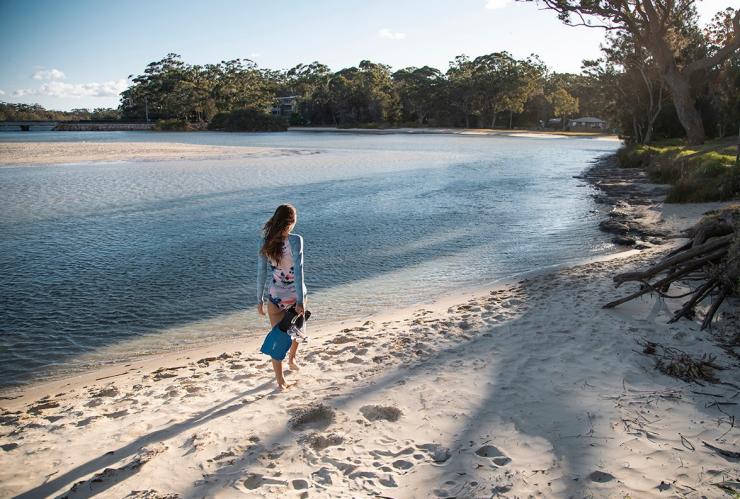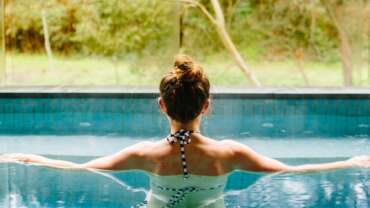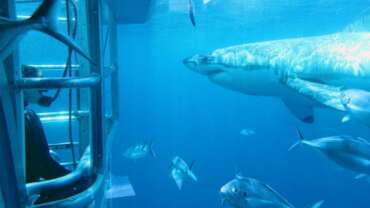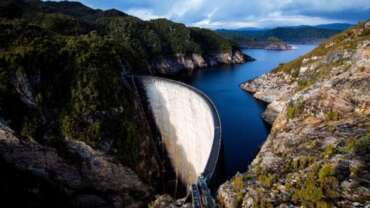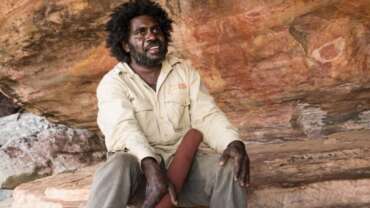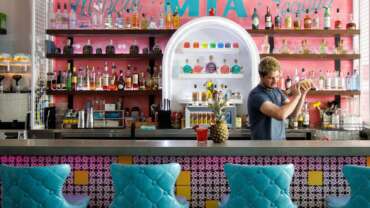Beaches and Islands in Australia
Go beyond well-known destinations to discover Australia’s beach and island gems. You’ll soon learn why the sand and sea hold such a special place in our national identity.
From city beaches to secluded spots where you’ll share the sand with more wildlife than humans, there are gorgeous beaches and islands across the country. Sail through the Whitsundays, marvel at a sea of red crabs on Christmas Island or embark on a coastal drive in search of the perfect spot for a surf. It won’t take long to find.
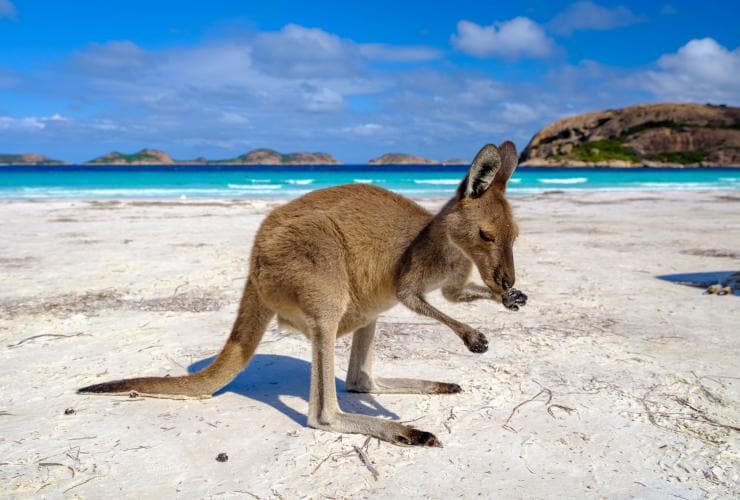
Australia’s best beaches
Bright blue waters, soft sand and incredible surf are just a few things you’ll enjoy at any one of Australia’s most beautiful beaches.
Beaches are a favourite Australian pastime. Whether it’s a game of cricket, an early-morning surf or a lie in the sunshine, beach culture truly encapsulates the ‘no worries’ attitude that defines so much of Australia. The beach is a place that exudes calm and relaxation, and with so much coastline to go around, it’s not hard to find a quiet space of sand all to yourself.
Beaches near Perth
Cottesloe Beach
While many of Western Australia’s most impressive beaches lie in remote locations, you’ll find one of the state’s best beach attractions just a 30-minute drive from Perth. A favourite for both locals and visitors, Cottesloe Beach is divided into three sections. The main area of Cottesloe Beach is perfect for swimming and walking, while North Cottesloe Beach is home to Peter’s Pool – a great spot for snorkelling. South Cottesloe doesn’t have any sand for sunbathers, but it does have amazing waves for local surfers.
Lucky Bay
Down in Western Australia’s southwest corner, Lucky Bay is a stunningly beautiful crescent of white sand and turquoise water, sitting untouched within the protection of Cape Le Grand National Park. Views of the islands of the Recherche Archipelago, and sharing the beach with sunbaking kangaroos, make a trip to Lucky Bay an unforgettable experience.
Cable Beach
In Broome, located on the northern border of Western Australia, you’ll find Cable Beach. This beach is famous for its 22 kilometres (14 miles) of soft white sand, where visitors can enjoy the serene surrounds and calm blue water. Cable Beach is also known for its camel trains, where guests traverse the beach on the backs of camels for a memorable way to watch one of Western Australia’s epic sunsets.
Beaches near Darwin
Mindil Beach
Near the Northern Territory town of Darwin is Mindil Beach. Although swimming isn’t recommended, the beach is still well worth a visit because of the festivities that happen along its shores during the dry season. At the Mindil Beach Sunset Markets, you’ll find food from all over the world as well as an incredible view of the town’s famous sunsets. If you need to cool off, visit Darwin’s Waterfront Precinct. Located just a five-minute walk from the city centre, you’ll find a man-made lagoon for children, a popular wave pool, a saltwater beach and several great eateries.
East Point Reserve
The Northern Territory is known for its remarkable red dirt, but it also boasts some beautiful beaches. While many of the state’s beaches aren’t recommended for swimming because of their marine life, you’ll find a lovely saltwater lake at East Point Reserve, located just 15 minutes from Darwin. Lake Alexander is a popular spot for paddleboarding and swimming as well as beachside yoga and reading. Nearby, you’ll find a paved nature walk that takes you along the coastal cliffs.
Wagait Beach
On the opposite side of Darwin’s harbour, you’ll find Wagait Beach. The quiet, secluded beach is often considered one of Darwin’s local secrets, offering stretches of sand and green forest walks. Wagait Beach is a 90-minute drive or 15-minute ferry from Darwin.
Beaches near Adelaide
Henley Beach
As the coastal capital of South Australia, Adelaide is home to several metropolitan beaches. Henley Beach, home to white sand and gentle surf, is popular among locals and visitors. Walk along the jetty out to sea, or stop by one of the many bars and restaurants along the shore to taste local wine and beer.
Glenelg
Glenelg is perhaps Adelaide’s favourite family-friendly beach. Here, you’ll find a tree-lined beach with calm, blue waters. Take a walk down the nearby Jetty Road to find busy cafes and bustling shops.
Sellicks Beach
Near the relaxed wine country of McLaren Vale you’ll find beaches that seem to stretch forever. Spend a morning at Sellicks Beach where you can swim, surf and fish. Or take a drive over to Goolwa Beach to spot dolphins from the sand, cast a line out in the water or dig for cockles with your feet.
Stokes Bay
If you’re keen to get out of the city, don’t miss the incredible experiences at Stokes Bay on Kangaroo Island, about 3.5 hours from Adelaide. Stokes Bay Beach may have an unusual entrance through a natural rock tunnel, but visitors are rewarded with a secluded stretch of stunning white sand. But the scenery isn’t all you’ll enjoy at Stokes Bay. Atop the grassy cliff, you’ll often find kangaroos enjoying a meal. Stay at the Waves & Wildlife Cottages to see native wildlife right outside your door.
Gunyah Beach
Gunyah Beach, located on the Eyre Peninsula, is known for its spectacular surfing, showcasing some of Australia’s biggest rips. But the surf isn’t the only thing that makes this beach famous. Just off the beach lies the amazing Gunyah sand dunes, which stretch as far as you can see.
Beaches near Cairns
Queensland is home to some of the most iconic beaches in Australia. The Gold Coast, the Sunshine Coast and the Great Barrier Reef all create their own unique stretches of sand and surf.
Whitehaven Beach
Perhaps the most famous is Whitehaven Beach, and it’s no mystery why. Located in the breathtaking Whitsunday Islands, the sand seems impossibly white as it swirls together with pristine turquoise water. Visit the beach during a variety of Whitsunday cruises, or stay on Hamilton Island and take the 30-minute boat ride.
Cape Hillsborough
About 1.5 hours south of the Whitsundays lies a beach with bountiful wildlife. Cape Hillsborough plays host to kangaroos and wallabies each day at sunrise, when the sand reflects the golden sky. Wake up early and bring your camera to capture the spectacle.
Beaches near Brisbane
Noosa
Drive just two hours north from Brisbane and you’ll stumble upon Noosa, a sleepy seaside town with impeccable beaches. Visit Noosa Main Beach for calm waves and beautiful blue water. Sunshine Beach offers 15 kilometres (9.3 miles) of open beach bordered by tropical palm trees.
Burleigh Heads Beach
The Gold Coast, just over an hour south of Brisbane, is another hot spot for beautiful beaches. Burleigh Heads Beach, simply called Burleigh by the locals, is a favourite for a surf, swim and barbecue. Find calm, sheltered waters just out from the sand, or great surf waves when you move to the other side of the seaside cliffs. Step off the sand to find a shady spot for a picnic or barbecue.
For a beach experience of the adventurous sort, start off in Noosa and spend four days on The Great Beach Drive. Along the way you will take your 4WD on the sands of Rainbow Beach and Fraser Island as you spot whales, dolphins and even dingoes en route.
Beaches near Sydney
Shelly Beach
Thousands of people soak up Sydney’s beaches every year, but there’s more to explore than the big name beaches of Manly and Bondi. Manly Beach’s lesser-known neighbour, Shelly Beach, is not only great for surfing but also snorkelling and scuba diving. The shallow marine reserve offers sheltered water perfect for families as well. After your swim, take the easy track up the headland for scenic views out to the ocean. Alternatively, grab a bite to eat at The Boathouse Shelly Beach, one of the area’s buzzy cafes.
Palm Beach
Drive along the coast north from Sydney and you’ll find a chain of beaches aptly named the Northern Beaches. Palm Beach, located just over an hour from Sydney, is known for its clean golden sand and great bush walks. Beyond the beach, you can play a few holes at Palm Beach Golf Club, take a Hidden Treasures cultural tour or dine at acclaimed restaurants like Jonah’s.
Main Beach
In New South Wales’ beachy city of Byron Bay, you’ll find several world-class beaches. Main Beach stretches straight out from the town, offering soft golden sand and crystal clear water. Other local favourites include Wategos Beach and Seven Mile Beach.
Coalcliff Beach
If you’re headed south along the stunning Grand Pacific Drive, don’t miss Coalcliff Beach in Wollongong, less than two hours from Sydney. Surrounded by rocks and cliffs, the beach is a great spot for swimming, surfing and fishing. Head to the southern tip of the beach to find a calm saltwater pool perfect for a relaxing dip. Coalcliff faces east, so arrive at sunrise to witness some spectacular colours reflected on the water.
Beaches near Canberra
Jervis Bay
Because the Australian Capital Territory (ACT) is landlocked, it doesn’t have any ocean beaches. However, you don’t have to go far to find a stretch of sand by the sea. Head to the Jervis Bay region of the South Coast, located in New South Wales about 2.5 hours from Canberra, for countless beautiful beaches. One of these is Pretty Beach. With glassy water and lush greenery, its name is well-deserved. You may even spot friendly kangaroos sharing the sand.
South Broulee Beach
Huskisson is also a frequented area where you can find stunning white sand beaches perfect for spotting dolphins from shore. South Broulee Beach offers nearby sand dunes that are great for a picnic, while Guerilla Bay provides sheltered waters, dramatic rock cliffs and a secluded spot of sand.
Beaches near Melbourne
Brighton Beach
Victoria offers expanses of wilderness to explore, but one of the state’s best beaches is just 30 minutes south of Melbourne. On Brighton Beach, you’ll savour the soft golden sand and calm ocean water, as well as the exceptionally photogenic bathing boxes. Over 80 small, colourful wooden structures line the foreshore, making Brighton Beach one of Australia’s most charming.
Ninety Mile Beach
Further from the city, escape to secluded beaches in Gippsland, a region in southeast Victoria boasting forests, mountains, rivers and villages. One of the most stunning beaches in Gippsland is Ninety Mile Beach, a 145-kilometre (90-mile) stretch of sand that separates the Gippsland Lakes from the Bass Strait. Meander down the coastline, keeping an eye out for dolphins and whales that may pass by.
Bells Beach
If you’re driving Victoria’s striking Great Ocean Road, you’ll pass one of the state’s best surf beaches. Bells Beach, located an hour and a half from Melbourne, is the arena for the Rip Curl Pro Bells Beach, which draws some of the most impressive surfers from around the world. The beach is enveloped by rock cliffs, giving visitors a sweeping view of the sand below.
Beaches near Hobart
Seven Mile Beach
Tasmania is renowned for its jaw-dropping nature, including some exceptional beaches. Just 20 minutes from Hobart lies Seven Mile Beach, a long crescent of sand dotted with hills, pine forests and luxe resorts. Take a dip on the beach’s western end, or embark on a bushwalk across the headland.
Wineglass Bay
Wineglass Bay is one of Tasmania’s most famous beaches, and it won’t take long for you to discover why. Located about 2.5 hours from Hobart among the wild beauty of Freycinet National Park, Wineglass Bay is a perfectly curved expanse of white sand bordered by incredibly clear blue water. Although you can walk to the beach itself, one of the most beautiful ways to enjoy the beach is from a lookout above the bay. Set off on the 3-kilometre (1.9-mile) return hike from the Wineglass Bay carpark to see the vibrant colours from a new perspective.
Bay of Fires
Some of the most unique beaches you’ll find in Australia lie within Tasmania’s Bay of Fires, located a 2.5-hour drive from Launceston. Famous for its brilliant white beaches, turquoise water and bright orange rocks, the Bay of Fires is as stunning as it is secluded. Nearly 30 kilometres (18 miles) of white sand stretches the coast. Head to Binalong Bay to dive into the crystal sea.
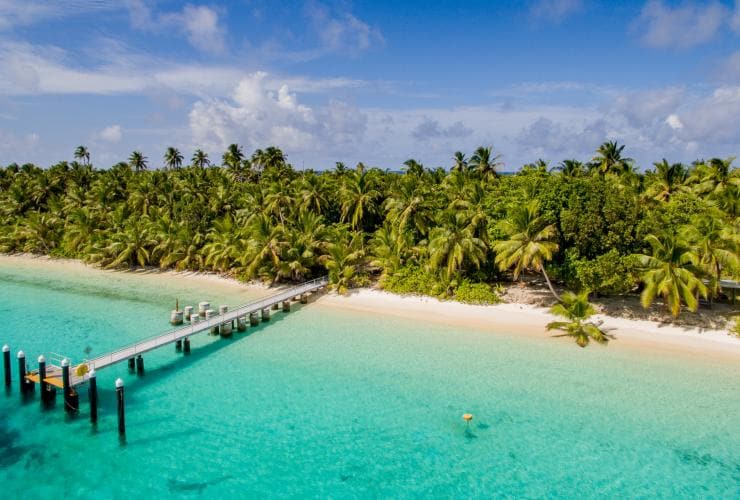
Australia’s most beautiful islands
In the open ocean or just off the coast, Australia is home to some of the world’s most enviable island experiences.
Australia is surrounded by stunning islands. Luxurious, adventurous, rugged or remote – there’s an island suited to every paradise seeker.
Here are Australia’s best and most beautiful islands.
Islands near Perth
Cocos (Keeling) Islands
This idyllic Indian Ocean outpost of 27 islands boasts dazzling white-sand beaches, world-class diving and a unique cultural blend – yet it receives only a handful of visitors each year, perhaps due to its remote location off Australia’s west coast. Those who do make the trip from Perth (via Christmas Island) will be handsomely rewarded: divers of all abilities can marvel at coral reefs and shipwrecks with Cocos Dive; curious historians can take a guided tour to learn about the local Cocos Malay people; and explorers can visit the territory’s untouched southern islands on an outrigger canoe safari. Don’t miss calm Cossies Beach on Direction Island; it’s been called Australia’s best beach.
Rottnest Island
Rottnest Island, just a short ferry ride from Perth, has one tiny attraction you can’t see anywhere else. The quokka, a pint-sized marsupial, is known for its friendly nature, which is why photographers love to snap their picture. The island is a true sanctuary: private cars are not allowed, so most visitors explore the place on foot or by bicycle, wandering between 63 charming beaches with snorkels in hand. Families will love the Just 4 Fun Aqua Park, and there are some great places to scuba dive. If you’re keen to cover the entire island, the hop-on hop-off Island Explorer bus is a great option. Stay in a luxury eco-tent nestled behind the sand dunes.
Christmas Island
If you’re chasing an island experience that’s as remote as it is unknown, then Christmas Island is one to put on your list. Reached via a flight from Perth, Christmas Island is known not only for its incredible red crab migration, but also its untamed rainforest, lively coral reefs and luxury retreat. Each year during October or November, more than 40 million red crabs carpet the island during their migration. You can snorkel and scuba dive nearly 60 sites all year round, and with almost two-thirds of the island covered in national park, there are plenty of cliffs, rock pools and beaches to discover. You’ll find the ultimate island getaway at Swell Lodge, a single glass-fronted eco chalet offering views of the surrounding wilderness.
Islands near Darwin
Tiwi Islands
The Tiwi Islands, located 100 kilometres (62 miles) north of Darwin, overflow with culture, art and beauty. Take a tour with AAT Kings and be welcomed with a smoking ceremony before watching Tiwi women weave baskets and learn some of the complex rituals associated with the Pukamani (burial ceremony). Avid anglers will love a guided sport-fishing experience with Tiwi Island Adventures; there are more than 40 fish species to catch.
Islands near Adelaide
Kangaroo Island
Kangaroo Island, 13 kilometres (8 miles) off the coast of South Australia, has everything you need for a unique adventure. Wildlife, natural attractions, gourmet produce and delicious spirits all make an appearance. Head to the western side of the island to explore Flinders Chase National Park, home to large boulders covered in orange lichen; they’re called Remarkable Rocks for a reason. You don’t want to miss Seal Bay Conservation Park, where you can walk among endangered Australian sea lions. The two-hour Platypus Waterholes Walk will give you a chance at spotting Australia’s elusive platypus. Indulge in the island’s culinary creativity at Penny’s Restaurant, Kangaroo Island Spirits and Dudley Wines.
Islands near Brisbane
Fraser Island
Wild dingoes, breaching whales and beaches that double as roads are just a few of the things you’ll find on Fraser Island. Located about a six-hour drive north of Brisbane, Fraser Island is the perfect getaway for those who like to roam free. Discover the island’s welcoming waters at Lake McKenzie and Lake Wabby; you won’t be able to resist a relaxing swim. Driving along the island’s incredible beaches is a way of life on Fraser Island. Visit Aussie Trax 4WD Hire for a vehicle and a quick lesson on navigating the sandy highways. Visit during migration season (August through October) to spot giant humpbacks on a whale watching cruise. At dusk, try to spot wild dingoes with a local guide before settling into your campsite on the beach or resort accommodation. If you have a few days to spare, consider trekking the Fraser Island Great Walk, where you’ll reconnect with nature along the winding coastal path.
Moreton Island
Made entirely of sand, Moreton Island is the perfect setting for a laid-back beach getaway. Stay at Tangalooma Island Resort for stunning views over Moreton Bay and the Glass House Mountains. You can even hand-feed wild dolphins here. Snorkel among the sunken ships of the Tangalooma Wrecks, a man-made dive site that’s now home to fish, dolphins and dugongs. You can’t stay on the sand island without a bit of sandy adventure; take a Desert Safari tour to sail down the golden dunes on a toboggan. There are also plenty of walking and hiking trails to tackle, from the easy Blue Lagoon to the more difficult, but rewarding, Mount Tempest Lookout walk.
North Stradbroke Island
Wild kangaroos, white-sand beaches, and humpback whales come together to create the perfect island adventure on ‘Straddie,’ the local’s nickname for North Stradbroke Island. The island is an easy ferry or water taxi from Brisbane, and offers all-day sunshine with a good dose of rugged nature. Head to Cylinder Beach, Flinders Beach and Frenchmans Beach to enjoy long stretches of sand, or climb to Point Lookout with a pair of binoculars to spot whales from late May and early October. Hike to Blue Lake and Brown Lake, which are areas of special cultural significance for Quandamooka people. Stay in comfort under the stars at the Minjerribah glamping tents.
Islands near Cairns
Whitsundays
The Whitsunday Islands, located in Queensland’s Great Barrier Reef, boast some of the country’s most beautiful nature. There are 74 islands in the Whitsundays, but only some offer the chance to stay amid the azure waters and white sand. Hamilton Island is home to qualia, one of the most luxurious stays on the reef, while Daydream Island offers a one-of-a-kind Living Reef, along with breathtaking views and aquatic activities. Hayman Island is a private island paradise. Check into InterContinental Hayman Island Resort for a huge swimming pool, suites and villas, seaplane adventures and a trip to the famous Whitehaven Beach or Heart Reef.
Magnetic Island
It only takes 25 minutes on a ferry from Townsville to arrive at the palm-fringed paradise of Magnetic Island. Although the island is a part of the Great Barrier Reef Marine Park, it’s rocky landscape dotted with boulders makes it beautifully unique. Snorkel and dive through coral and shipwrecks, or explore atop the water with a kayak or jet ski tour. After you emerge from the sea, head to the Bungalow Bay Koala Village to visit the furry residents at the koala park. There is even the option to have breakfast with the koalas. Finally, enjoy the sunset the Australian way – from a boat on the open sea. Big Mama Sailing and Pilgrim Sailing offer sunset cruises. There are plenty of beautiful places to stay, too, including Lotus House and Peppers Blue on Blue.
Lizard Island
Lizard Island rests within the blue waters of the Great Barrier Reef, so it’s no surprise that a trip here is all about reef and relaxation. Your stay at the five-star Lizard Island Resort offers equal parts luxury and adventure, with experiences ranging from fishing and diving to spas and private dining. Don’t miss your opportunity to snorkel some of the reef’s most incredible dive sites, including Cod Hole, where you can swim alongside grey reef sharks and schools of tropical fish. After a day in the water, unwind with a private picnic or fresh seafood on the waterfront. For a jaw-dropping view of the swirling blues surrounding the island, hike the four kilometres (2.5 miles) to Cook’s Look.
Islands near Sydney
Norfolk Island
Norfolk Island’s undulating, pine-tree-covered hillsides hide a dramatic secret: this speck in the ocean was once Australia’s most notorious penal colony. These days, it’s better known for its gorgeous scenery and fiercely proud residents (many of whom are convict descendants) – but the original penal buildings still stand in the Kingston and Arthurs Vale Historic Area, providing a vivid look at the past. Once you’ve brushed up on your history, play a scenic round of golf on one of the world’s only courses located in a World Heritage Site; laze on the golden-sand beach that fronts Emily Bay Lagoon; or check out the island’s immense basalt and sandstone cliffs on a kayak tour. On-island accommodation and dining options are plentiful, and flights depart regularly from Sydney and Brisbane.
Cockatoo Island
Australia has hundreds of islands, and you don’t have to venture far from the city to find them. This is especially true in the case of Cockatoo Island, located within the glistening Sydney Harbour. You can get there on a ferry from Circular Quay, and there’s plenty to explore after you arrive. The island has a colourful history as a jail and shipbuilding yard, and you can discover it’s heritage on a range of tours. Embark on the Cockatoo Island Ghostyard tour or Haunted History tour for a few ghost stories. You can even spend the night. Choose between heritage houses, apartments and waterfront camping tents.
Lord Howe Island
It’s just a quick flight from Sydney or Brisbane, but lush Lord Howe Island feels much further away – partly because only 300 people live there and just 400 visitors are allowed at any one time. The island’s big draws are its biodiverse coastline and mountain-studded interior, both of which can be explored by novices and pros alike. Experienced adventurers should hike Mount Gower for jaw-dropping views and dive near Ball’s Pyramid, an offshore rock, to see endemic species. A less strenuous – but no less impressive – option is a glass-bottomed boat trip with Lord Howe Environmental Tours. On-island accommodation ranges from the elegant Pinetrees Lodge to the luxury boutique Capella Lodge.
Islands near Melbourne
Phillip Island
Just a 90-minute drive south of Melbourne is Phillip Island, famous for its abundance of wildlife. Begin your animal adventure at the Koala Conservation Centre, where you’ll stroll through the bush to spot koalas in their native habitat. Next, take a trip with Wildlife Coast Cruises to Seal Rocks to see one of the largest colonies of Australian fur seals. Alternatively, visit Nobbies Centre, where you can see Australian fur seals from the land for free. Afterwards, stroll the boardwalks with terrific views of Phillip Island’s rugged south coast and blowhole. One of the island’s must-dos is watching the Phillip Island Penguin Parade, where wild little penguins emerge from the sea and waddle across the beach to their dune burrows.
Islands near Hobart
Flinders Island
The wild, green islands of the Furneaux Group dot the Bass Strait, a stormy patch of ocean that stretches between mainland Australia and Tasmania. The largest of the islands, Flinders, is the most captivating of the lot: it’s full of sandy beaches, rambling hillsides and tracts of thick bushland. Tasmanians love the place for its atmosphere and its incredible seafood, particularly the famed Flinders Island crayfish – book a Rockjaw Tour to catch some yourself. Take a walk through Strzelecki National Park to admire its moody granite mountains and little-known Aussie marsupials such as Bennetts wallabies, Tasmanian pademelons and potoroos. Or book a room at Sawyers Bay Shacks for barefoot luxury and genuine relaxation. Flinders can be reached via plane from Launceston or via ferry from nearby Bridport.
Bruny Island
Bruny Island is a wildlife and wilderness haven. After a 30-minute drive from Hobart and 20-minute ferry from Kettering, hop on a wilderness cruise with Pennicott Wilderness Journeys to discover the wild coastline of the island, as well as Australian fur seals, dolphins, migrating whales and sea birds. Spend your afternoon collecting culinary delights on the island by visiting Get Shucked Oyster Bar, Bruny Island Cheese Company, Bruny Island Premium Wines, or Bruny Island House of Whisky. After such an eventful day you’ll want nothing more than to enjoy a chilled out evening. Book in at Hundred Acre Hideaway and take advantage of your cottage deck, positioned to overlook 100 acres of bush, rainforest and meadows.
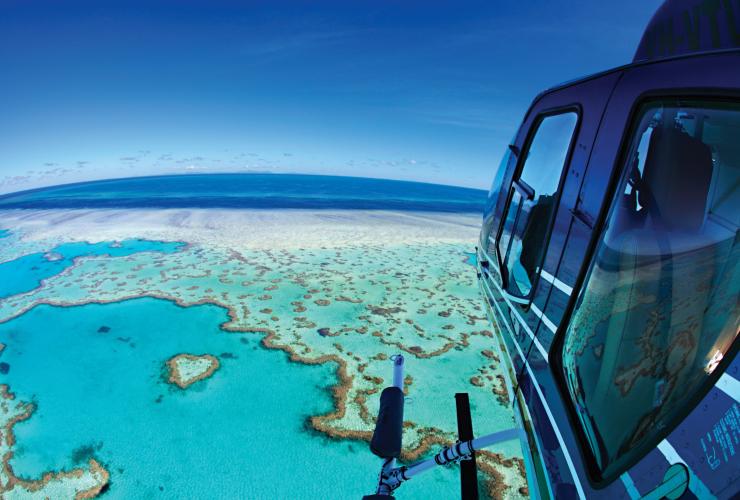
Australia’s coral reefs
No doubt you’re familiar with the Great Barrier Reef, but did you know that Australia’s incredible coastline is also peppered with other reef systems waiting to be discovered?
Millions of visitors make the pilgrimage to see the Great Barrier Reef every year. Snorkelling and diving among the colourful fish and coral; spotting turtles, sharks and whales; or even experiencing the wonders of the reef while staying dry in a glass-bottom boat, helicopter or seaplane.
There are so many unique ways to experience the reef, and it’s a bucket-list item that every traveller should tick off. Yet while the Great Barrier Reef often takes centre stage, it’s not the only incredible reef system you can find in Australia. The country’s northern, western and south eastern coastlines are also underwater playgrounds with their own unique ecosystems waiting to be explored.
Discover each of Australia’s unique and diverse reef systems for yourself.
The Great Barrier Reef
The Great Barrier Reef may be Australia’s most well-known natural asset, and it’s no wonder this natural wonder of the world is a huge bucket list item for travellers of every age. It’s simply spectacular.
At 2,300 kilometres (1,430 miles) the Great Barrier Reef is the largest coral reef system in the world. It’s home to over 1,600 species of fish, 411 species of hard coral and 150 species of soft coral, more than 30 species of whales and dolphins and six of the world’s seven species of marine turtles.
Whether you snorkel, scuba or view this underwater playground from a glass-bottom boat, be sure to keep track of your progress as you attempt to catalogue the reef’s “Great Eight” – manta rays, whales, turtles, clownfish, potato cod, giant clams, maori wrasse and sharks. You can also experience sailing and fishing charters as well as helicopter and seaplane adventures that showcase the reef from above. A scenic flight above Heart Reef is a romantic excursion that every couple will cherish.
As the reef spans two thirds of the north eastern coastline of Australia, you’ll find many jumping off points for accessing the incredible adventures that await you here. Cairns in the tropical north and Airlie Beach in the Whitsundays region are perhaps the two best known gateways towns. Explore the stunning tropical surrounds and luxury resorts of Hamilton, Hayman and Daydream Islands. Or opt for a secluded getaway on Orpheus, Lizard or Bedarra Island. Visit the koala population on Magnetic Island or take a scenic flight and spend an afternoon on a temporary island. Vlasoff Cay will be your private playground for a few hours at low tide where you can swim, sunbathe and picnic in total serenity.
The Southern Great Barrier Reef
While technically part of the massive Great Barrier Reef system, the southern end of the reef offers unique experiences that differentiate it from the areas found in the tropical north. Starting in the coastal city of Bundaberg (about a 4.5-hour drive north of Brisbane) and stretching up the Capricorn Coast, the Southern Great Barrier Reef is home to colourful coral cays, authentically Aussie seaside towns and island jewels waiting to be discovered.
The idyllic islands that dot the Southern Great Barrier Reef offer eco escapes, extraordinary snorkelling and easily accessible diving opportunities. From Heron Island you can snorkel right off the beach, or take a boat just 15 minutes to reach 21 different dive sites. Lady Musgrave is the perfect day trip for experienced and first-time snorkellers alike, while Lady Elliot ranks in as one of the world’s top five places to dive with giant manta rays. At Great Keppel Island you can choose to relax and disconnect or find adventure by walking into the water and snorkelling the fringing reef from one of 17 quiet beaches that circle the island.
The Southern Great Barrier Reef is also the perfect place to witness all the stages of a turtle’s life cycle for yourself. From watching turtles nest on Heron Island to witnessing hatchlings scamper to the sea on Mon Repos Beach, it’s a unique opportunity to get up close to this incredible phenomenon.
Ningaloo Reef
Ningaloo Marine Park is a World Heritage-listed site that sits about 1,250 kilometres (777 miles) north of Perth.
Start your journey in the hub town of Exmouth (if you plan to drive, there are plenty of worthy stops along the way, otherwise you can fly to Exmouth from Perth) where you’ll be introduced to the crystalline waters that harbour the world’s largest fringing reef. At 260 kilometres (162 miles) long, Ningaloo Reef’s coral system is swarming with turtles, tropical fish, manta rays, humpback whales and the elusive whale shark.
Whale shark season (every year from April to July) is one of the most exciting times here, as there is no other place on Earth where these gentle giants reliably congregate in such large numbers so close to land. Swimming with one of these beautiful creatures is one of life’s most breathtaking experiences. Strict protections are in place to care for threatened species and all charter boats collect data for scientists and conservationists to ensure Ningaloo’s aquatic visitors stay safe. Join a tour in Exmouth or Coral Bay and pick a boat with its own spotter plane for best results. The Exmouth Visitor Centre can provide you with the many tour options available.
More than 500 species of fish also live in these waters, so grab a snorkel and see how many you can spot at popular snorkel spots such as Bills Bay and Purdy Point at Coral Bay, or Oyster Stacks and the Turquoise Bay Drift in Cape Range National Park. Look for elegant angel fish and Moorish idols, vibrantly coloured parrot fish and butterfly fish, and tiny damselfish. Divers can get up close with even more varieties of fish at sites such as Exmouth’s Navy Pier, where big schools of snapper and massive grouper fish are frequent visitors.
There are also three species of turtle found on Ningaloo Reef – the green, loggerhead and hawksbill turtles. At the Jurabi Turtle Centre, outside the town of Exmouth, you can learn more about these extraordinary animals, and even take part in a guided turtle viewing experience. From December to March you can watch turtles laying their eggs. Or come six weeks later to see the hatching process, when the tiny turtles dig their way out of the sand and race towards the ocean, trying to escape waiting predators including ghost crabs and spangled emperor fish.
Montgomery Reef
Montgomery Reef, in the Lalang-garram/Camden Sound Marine Park on the Kimberley Coast, is one of the most spectacular places in the Kimberley. Covering nearly 300 square kilometres (116 square miles) across the Indian Ocean, the tidal movements here vary by up to 10 metres (33 feet) causing the reef to emerge from the sea at low tide. The result is a cascading waterfall from the top of the reef as an abundance of marine life comes into view. Navigable channels through the reef allow boats to tour the area and view the spectacle.
While cruising Montgomery Reef you’ll be sure to spot a variety of marine life, including six species of turtle, Australian snubfin and Indo-Pacific humpback dolphins, dugongs, saltwater crocodiles and several species of sawfish as well as humpback whales, minke whales and false killer whales.
The marine park is also the most important humpback whale nursery in the Southern Hemisphere. From June to November each year up to 20,000 humpback whales migrate from their Antarctic feeding grounds to their breeding grounds on the Kimberley Coast.



